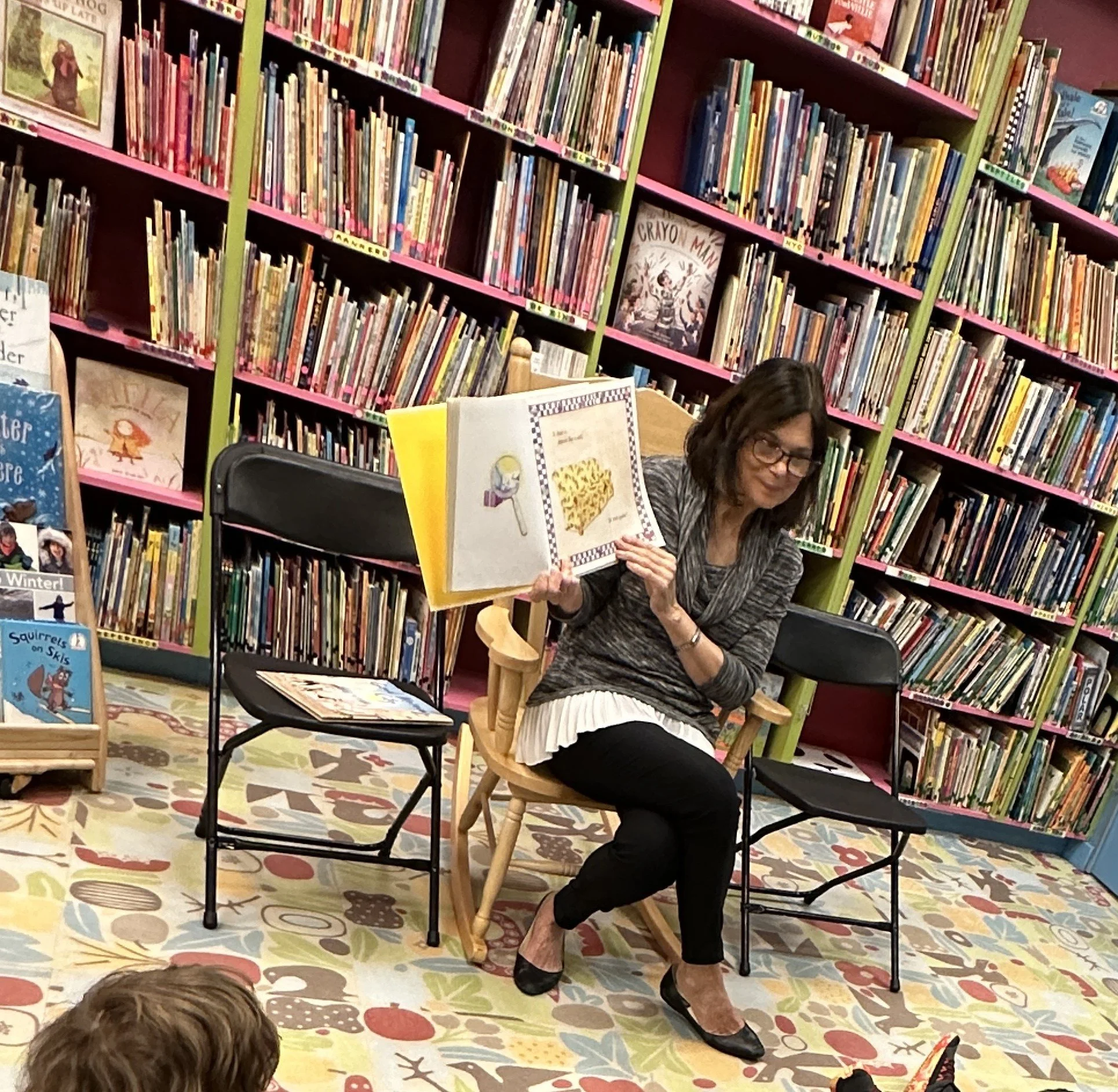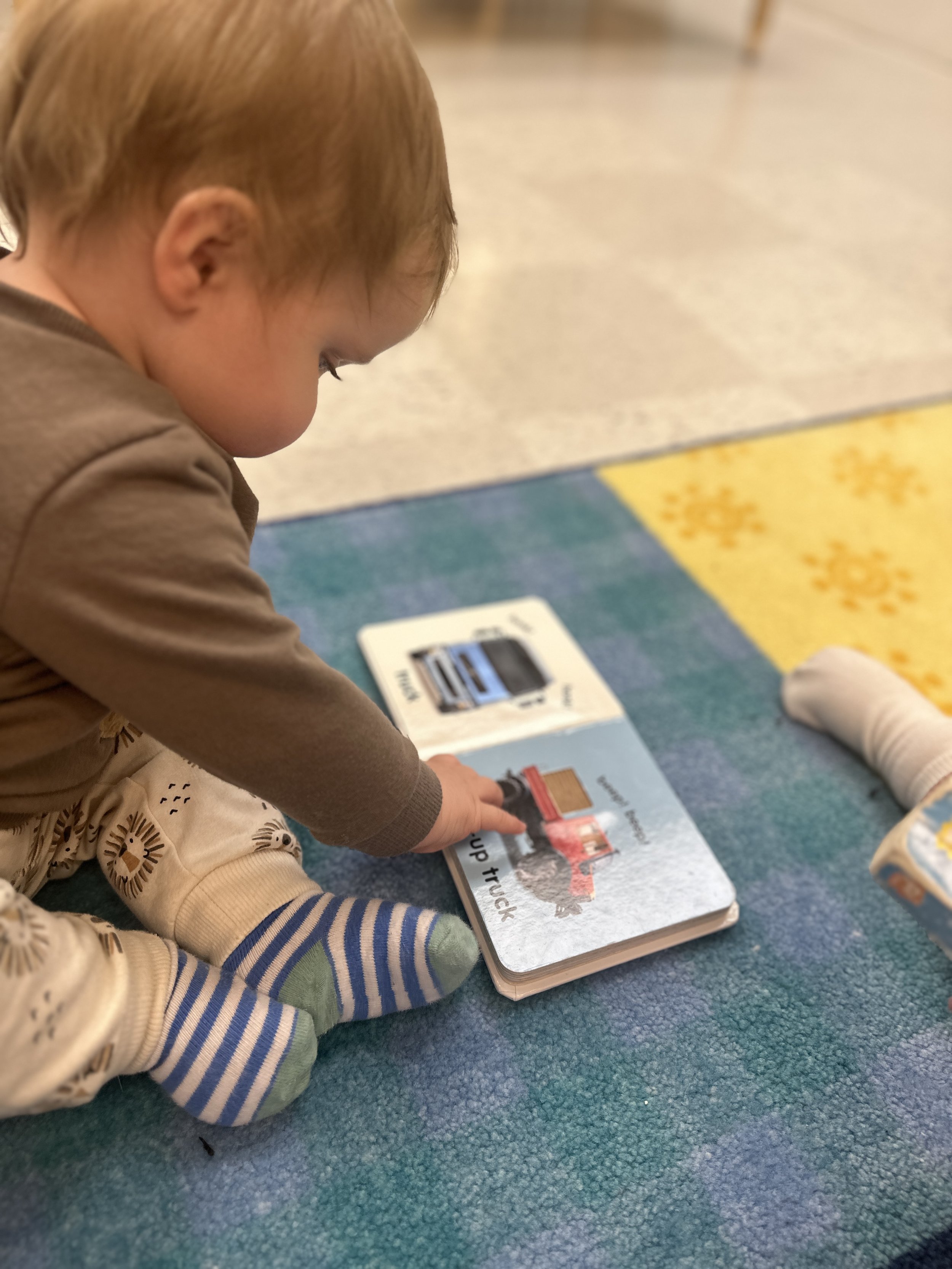The Importance of Early Childhood Libraries
Ms. Katherine holds up a book for the class to see.
At York Avenue Day School, we are committed to providing a strong academic, social, and emotional foundation that is essential to the success and development of children. Not only is this done in the classroom, but through daily specials and enrichment classes. One such special is Library, with our dedicated librarian Ms. Katherine.
Ms. Katherine has been the librarian at York for the past 13 years and has grown the library and the library program extensively over that time. In the following interview, Ms. Katherine shares how she came to York, the programs we offer, and the importance of dedicated early childhood libraries.
Hannah: How long have you been the librarian at York?
Katherine: 13 years
H: What made you decide to become an early childhood librarian?
K: It’s a funny anecdote. I was a general counsel and director of compliance for a large investment management firm and had been a lawyer since the 1990s. I had my daughter, Ruth, and I decided right before she was born, that it was important that I stay home. When she was two, we enrolled her at York. I found myself sitting on the couch and really felt lost because of the transition. In December of that year, the librarian that they had working at the time left York and the director at the time asked parents if they could come in and help out. We lived across the street and I had always had two interests, one was books and the second was teaching. When I was five, I was playing teacher, so I don’t know what took me off that path and into law but that was my childhood dream. So I was like, “Hey this might be fine for me to get up off the couch and go over there.” I found myself coming over here every single day. Finally, the director asked if I wanted the job. I didn’t feel qualified for the job, but she insisted, saying “You have a 2-year-old and you have a law degree, I think you can do it.” Thirteen years later, I’m still in the job and telling everybody that I feel really fortunate that I found my second career and maybe even my first career that I should have pursued because I really love it.
Ms. Katherine reads to the class.
To add to that, you may wonder why haven’t I branched out since I do love it so much. Why am I staying here? Partially it’s because it’s my baby. I grew this library from 2,000 books to 8,000 books. I’ve personally selected about 70% of them and I just kind of fell in love with the whole idea of being at the ground level to introduce books to kids. I feel it’s more important even now, which is why I haven’t moved on. I don’t see the same interest from children in reading. They’re not quite as captivated by all of the stories and find it harder to listen for longer periods of time. I think it is the lack of reading on a consistent and every day basis both with their families and in schools. That’s why I’m still here.
H: Tell us about the program for the different age groups
K: The Twos, Threes, and Fours all visit the library once a week and they spend half an hour here. We start off doing a read aloud. The time permits for two and I read the stories and engage them in a conversation about the stories. Then we have what we call choice time where the kids get to take home a book a week. I will present options to them. It is usually theme based. Either seasonal or something that they are working on in their curriculum. The Twos I present two choices. The Threes and Fours choose from the whole selection of books laid out. I feel it’s important to explain the books a little bit to them as well. They won’t just be seeing the title and cover; I’ll actually tell them the synopsis of the story. They choose, they bring them home in a little special book bag, they bring them back next week, and we do it all over again.
Children listen attentively as a book is read out loud.
The Fours get an extra library period where they do a nonfiction study. We pick a nonfiction book that we read and sometimes it is based on their interest. A lot of times it is based on themes that I have developed over the years. With nonfiction it is a lot of facts and a lot of information for them to hold in their heads. It is a 45-minute period so we developed a project to go along with the book. If it is science, it could be an experiment, if it is something that lends itself to an easy art project, we’ll do an art project but something for them to take home.
H: Why do you think library classes and having a library in the school is important for young children?
K: Oh my god! I could give you a laundry list. I really think it is very important especially at the early childhood level. There are so many lessons that we are teaching consciously and unconsciously so even in library class, not only are they learning about books but they are learning how to take care of books. The books are on the floor when we choose them and we teach them, “Please don’t step on them.” When they are holding the books, we are teaching them how to turn the pages, to take care of something that is precious and that is important. When they choose, they have to wait their turn, they have to keep in their heads the story they want, and that someone else might pick that story before it is their turn. They learn how to handle being upset about not getting that book. We help them learn to ask if there is another copy, or ask me to put it on hold for another time. That’s a really important lesson.
An author reads to the kids in the library.
Also I think that we are teaching language skills beyond literacy skills. When you are reading a story there’s a beginning, middle, end. Asking questions during the read aloud, retelling of the story or making observational comments — all of that is super important. Again, the literacy piece. I do believe that if you read to kids, if you let them touch the books, even if they take those books home and only look at the pictures, it’s valuable. Because of the competition with the digital media, I think it’s even more important at the early education stage, maybe even more so than elementary and middle school. Yes, it’s important. One thing I would say is elementary and middle schools should have digital media and should have computers. I wouldn’t have it at this level.
H: Having worked with children 2 – 5, how have you seen them progress through their understanding of literacy?
K: It definitely progresses in their understanding of their own self and their own desires and likes. So when you see a two-year-old making a choice, it is about the cover, do they recognize the character from a show, or something they’ve seen at home. Is it pretty? There’s a lot of visual choices being made. In the Threes, preferences start to develop. By the Fours, it is very clear what they like and what they don’t like. They are also very opinionated about it and are not shy about saying, “I don’t like any of those choices,” but if they spot something on the shelf, asking, “Can I take that one instead?” That is a fun progression to watch.
By the time they reach the Fours, you know the kids who are going to read early. They have that sense of curiosity about books and words. Those are the kids that I’ll give a chapter book to or an early reader by the time they reach the Fours. I think they can stretch to that. I’ll actually even give a Threes family a chapter book because I do think there are many Threes who are ready for that. If it doesn’t work, they aren’t going to pick it again. If it does, then you can introduce them to series and it is another way to progress.
H: In terms of the Infants and Ones, that is a new program for this year. How are you incorporating them into library?
K: So currently, we are still developing their library. We made a decision to have a main library and an annex where the annex would be books specifically for the Infants and Ones. The teachers are primarily using these books right now as the Infants and Ones are not coming to the library. It’s really a matter of trying to have the best way to have them come. It is a hope of mine to incorporate it progressively so as the Ones begin turning Two, we slowly start introducing it once a month or so. I think most early learning library programs at the public library also incorporate some sort of tactile and sensory activity such as bins or bags in order to make this a really fulfilling experience, we are working to do that as well.
H: What advice would you give parents regarding what to look for in library or literacy programs at schools?
K: Look to see that there is one because there is a remarkably low number of dedicated libraries for early programs. You’ll always see books in the classroom but that is often the only place you’ll see them. Or you will see another room with a couple shelves on the bottom which is primarily for teachers to use so it is a library but not a circulating library. If a school has a library, I would tell parents to ask if it is a circulating library. If it is a circulating library, what children get to participate and how often? I would also encourage parents to volunteer for their school libraries and find ways to get more books into those libraries whether it be through used book donations, or book drives. I would tell parents to ask the heads of schools how important is the library, and how important is the tactile experience of looking at a book and holding it is to the school.
H: Anything else to add?
K: Not really, except this is a great place!






